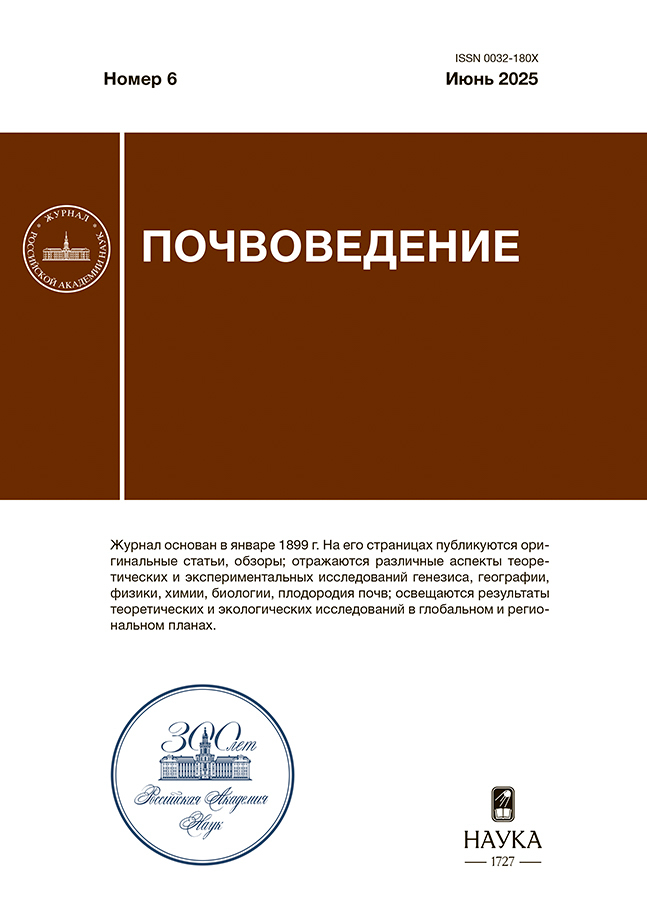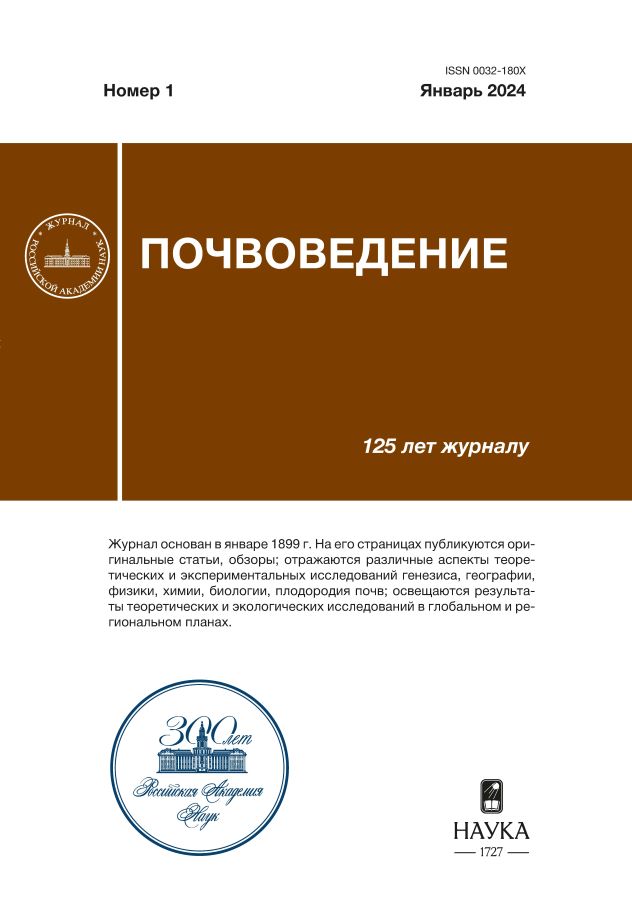Soil and Ecological Features of the Neo-Eneolithic Settlement “Algai” in the Lower Volga Region
- Authors: Ovchinnikov A.Y.1, Zanina O.G.1, Lopatina D.A.2, Vybornov A.A.3, Makshanov A.M.1
-
Affiliations:
- Institute of physicochemical and biological problems in soil science of the Russian Academy of Sciences
- Geological Institute of the Russian Academy of Sciences
- Samara State University of Social Sciences and Education
- Issue: No 1 (2024)
- Pages: 157-169
- Section: ПАЛЕОПОЧВОВЕДЕНИЕ
- URL: https://freezetech.ru/0032-180X/article/view/666690
- DOI: https://doi.org/10.1134/S0032180X24010121
- EDN: https://elibrary.ru/ZKUBIR
- ID: 666690
Cite item
Abstract
The results of the research of the archaeological settlement “Algai” located in the Lower Volga region, in the Alexandrovo-Gaysky district of the Saratov region are presented. The settlement of the Neo-Eneolithic period includes several archaeological cultural layers formed over the last 8 thousand years. Modern soils are represented by anthropogenically transformed light chestnut carbonate (Eutric Cambisol (Loamic, Protocalcic, Ochric)). The work used soil, paleosurface, paleobotanical methods, radiocarbon dating method. The soil stratum is represented by stratigraphically separated multi-temporal full-profile Holocene soils, showing different rates of Aeolian sedimentation and soil formation processes, vegetation change and anthropogenic presence in this area. Paleosurface and paleobotanical data showed that the natural environment of the territory was not stable throughout the Holocene, and dry steppes existed in the studied territory. The most active processes of sedimentation and soil formation occurred in the middle of the Holocene during the AT-2 period. During the stages of climate aridization, the processes of active sedimentation and the growth of oppressed vegetation took place, which affected the absence of a person in this territory. The stages of climate humanization were expressed in epigenic soil formation with the formation of organo-accumulative horizons, in various plant associations, in a rich species composition of wild animals, which indicates a favorable environment for human habitation in the region. The obtained materials showed the change of the natural environment in the studied area, the formation of Holocene soils of different times, and periodic human migration. Unlike modern soil, buried soils were formed in extremely arid conditions characterized by the formation of soda salinization processes of soils. The conducted research made it possible to obtain new data on the climatic, soil and paleobotanical features of the studied region.
Keywords
Full Text
##article.viewOnOriginalSite##About the authors
A. Yu. Ovchinnikov
Institute of physicochemical and biological problems in soil science of the Russian Academy of Sciences
Author for correspondence.
Email: ovchinnikov_a@inbox.ru
Russian Federation, Puschino, 142290
O. G. Zanina
Institute of physicochemical and biological problems in soil science of the Russian Academy of Sciences
Email: ovchinnikov_a@inbox.ru
Russian Federation, Puschino, 142290
D. A. Lopatina
Geological Institute of the Russian Academy of Sciences
Email: ovchinnikov_a@inbox.ru
Russian Federation, Moscow, 119017
A. A. Vybornov
Samara State University of Social Sciences and Education
Email: ovchinnikov_a@inbox.ru
Russian Federation, Samara, 443099
A. M. Makshanov
Institute of physicochemical and biological problems in soil science of the Russian Academy of Sciences
Email: ovchinnikov_a@inbox.ru
Russian Federation, Puschino, 142290
References
- Агрохимические методы исследования почв. М., 1975. 436 с.
- Александровский А.Л. Культурный слой: генезис, география, систематика, палеоэкологическое значение // Археология и естественные науки в изучении культурного слоя объектов археологического наследия. Матер. науч. конф. М.: Товарищество научных изданий КМК, 2018. С. 7–6.
- Аринушкина Е.В. Руководство по химическому анализу почв. М.: Изд-во МГУ, 1970. 487 с.
- Борисова О.К., Выборнов А.А., Юдин А.И. Палинологические данные к реконструкции природных условий в степном Поволжье в неолите/энеолите (поселение Орошаемое I) // Актуальные проблемы современной палинологии. Матер. XV Всерос. палинологической конф. М., 2022. С. 86–90.
- Вадюнина А.Ф., Корчагина З.А. Методы исследования физических свойств почв и грунтов. М.: Высшая школа, 1973. 399 с.
- Выборнов А.А., Юдин А.И., Васильева И.Н., Косинцев П.А., Кулькова М.А., Гослар Т., Дога Н.С. Новые данные по неолиту-энеолиту Нижнего Поволжья // Известия Самарского научного центра РАН. 2015. Т. 17. № 3. С. 235–241.
- Выборнов А.А., Юдин А.И., Васильева И.Н., Косинцев П.А., Кулькова М.А., Дога Н.С., Попов А.С. Исследования поселения Орошаемое в Нижнем Поволжье // Известия Самарского научного центра РАН. 2016. Т. 18. № 3. С. 140–145.
- Выборнов А.А., Юдин А.И., Васильева И.Н., Косинцев П.А., Кулькова М.А., Дога Н.С., Попов А.С. Новые материалы исследований на поселении Орошаемое в Нижнем Поволжье // Известия Самарского научного центра РАН. 2017. Т. 19. № 3. С. 185–190.
- Выборнов А.А., Лебедева (Овчинникова) Н.В., Овчинников А.Ю., Хохлов А.А. Обзор погребальных памятников неолита и энеолита лесостепного Волго-Уралья в контексте радиоуглеродных дат // Stratum. Прочнее меди. Сб. ст. к 80-летию В.А. Дергачева. Новосибирск, 2023. С. 243–258.
- Демкин В.А. Палеопочвоведение и археология: интеграция в изучении истории природы и общества. Пущино, 1997. 213 с.
- Демкина Т.С., Борисов А.В. Продуцирование CO₂ образцами подкурганных палеопочв степной зоны эпох относительной аридизации и климатического оптимума // Почвоведение. 2018. № 8. С. 943–951.
- Демкин В.А., Ельцов М.В., Алексеев А.О., Алексеева Т.В., Демкина Т.С., Борисов А.В. Развитие почв Нижнего Поволжья за историческое время. Почвоведение. 2004. № 12. С. 1486–1497.
- Ельцов М.В., Овчинников А.Ю., Митенко Г.В., Алексеев А.О. Отклик почв на изменение климата в степной зоне европейской части России за последние десятилетия // Почвоведение. 2021. № 12. С. 1437–1448.
- Иванов И.В., Александровский А.Л., Макеев А.О. и др. Эволюция почв и почвенного покрова. Теория, разнообразие природной эволюции и антропогенных трансформаций почв. М.: ГЕОС, 2015. 925 с.
- Иванов И.В., Васильев И.Б. Человек, природа и почвы Рын-песков Волго-Уральского междуречья в голоцене. М.: Интеллект, 1995. 264 с.
- Качинский Н.А. Методы механического и микроагрегатного анализа почвы. М.: Изд-во АН СССР, 1943. 45 с.
- Классификация и диагностика почв СССР. М.: Колос, 1977. 224 с.
- Кулькова М.А. Методы прикладных палеоландшафтных геохимических исследований. СПб.: Изд-во РГПУ им. А.И. Герцена, 2012. 152 с.
- Кулькова М.А. Радиоуглерод (¹⁴C) в окружающей среде и метод радиоуглеродного датирования. СПб.: Изд-во РГПУ им. А.И. Герцена, 2011. 40 с.
- Овчинников А.Ю., Выборнов А.А., Кулькова М.А., Занина О.Г., Лопатина Д.А., Дога Н.А., Юдин А.И., Алифанов В.М. Почвенно-экологические условия на нео-энеолитическом поселении “Орошаемое” в Нижнем Поволжье // Почвоведение. 2020. № 2. С. 165–177.
- Овчинников А.Ю., Выборнов А.А., Кулькова М.А., Макшанов А.М., Худяков О.И. Почвенно-экологические условия на территориях нео-энеолитических поселений Нижнего Поволжья // Почвоведение. 2022. № 11. С. 1341–1350.
- Палеопочвы как индикаторы эволюции биосферы. М.: НИА Природа, 2007. 282 с.
- Полупустынное Саратовское Приузенье: структура почвенного покрова, ландшафты и проблемы природопользования. Саратов: Наука, 2015. 193 с.
- Розанов Б.Г. Морфология почв. М.: Академический Проект, 2004. 432 с.
- Теории и методы физики почв / Под ред. Шеина Е.В., Карпачевского Л.О. М.: Гриф и К, 2007. 616 с.
- Чичагова О.А. Радиоуглеродное датирование гумуса почв. М.: Наука, 1985. 157 с.
- Юдин А.И. Варфоломеевская стоянка и неолит степного Поволжья. Саратов: Изд-во СГУ, 2004. С. 28.
- Юдин А.И., Выборнов А.А., Васильева И.Н., Косинцев П.А., Кулькова М.А., Гослар Т., Филиппсен Б., Барацков А.В. Неолитическая стоянка Алгай в Нижнем Поволжье // Самарский научный вестник. 2016. № 3(16). С. 61–68.
- Bennett N.J., Blythe J., Tyler S., Ban N.C. Communities and change in the anthropocene: understanding social-ecological vulnerability and planning adaptations to multiple interacting exposures // Regional Environ. Change. 2016. V. 16. P. 907–926. https://doi.org/10.1007/s10113-015-0839-5
- Hoffecker J.F., Holliday V.T., Anikovich M.V., Sinitsyn A.A., Popov V.V., Sinitsyn S.N., Levkovskaya G.M., Pospelova G.A., Forman S.I., Giaccio B. From the Bay of Naples to the River Don: the Campanian Ignimbrite eruption and the Middle to Upper Paleolithic transition of Eastern Europe // J. Human Evolution. 2008. V. 55. P. 858–870. https://doi.org/10.1016/j.jhevol.2008.08.018
- Holliday V.T., Hoffecker J.F., Goldberg P., Macphail R.I., Forman S.L., Anikovich M.V., Sinitsyn A.A. Geoarchaeology of the Kostenki-Borshchevo sites, Don River, Russia // Geoarchaeol. 2007. V. 22. P. 181–228. https://doi.org/10.1002/gea.20163
- Horák J., Klir T. Pedogenesis, Pedochemistry and the Functional Structure of the Waldhufendorf Field System of the Deserted Medieval Village Spindelbach, the Czech Republic // Interdisciplinaria Archaeologica Natural Sciences in Archaeology. 2017. V. 29. P. 43–57. https://doi.org/10.24916/iansa.2017.1.4
- IUSS Working Group WRB. World Reference Base for Soil Resources 2014. International soil classification system for naming soils and creating legends for soil maps. Update 2015. FAO, Rome, 2015. 192 p.
- Liu L., Jie, D., Liu H., Li N., Guo J. Response of phytoliths in Phragmites communis to humidity in NE China // Quaternary Int. 2013. V. 304. P. 193–199. https://doi.org/10.1016/j.quaint.2013.03.020
- Neumann K., Strömberg C.A.E., Ball T., Albert R.M., Vrydaghs L., Cummings L.S. International Code for Phytolith Nomenclature (ICPN) 2.0 // Annals Botany. 2019. V. 124. P. 189–199. https://doi.org/10.1093/aob/mcz064
Supplementary files














